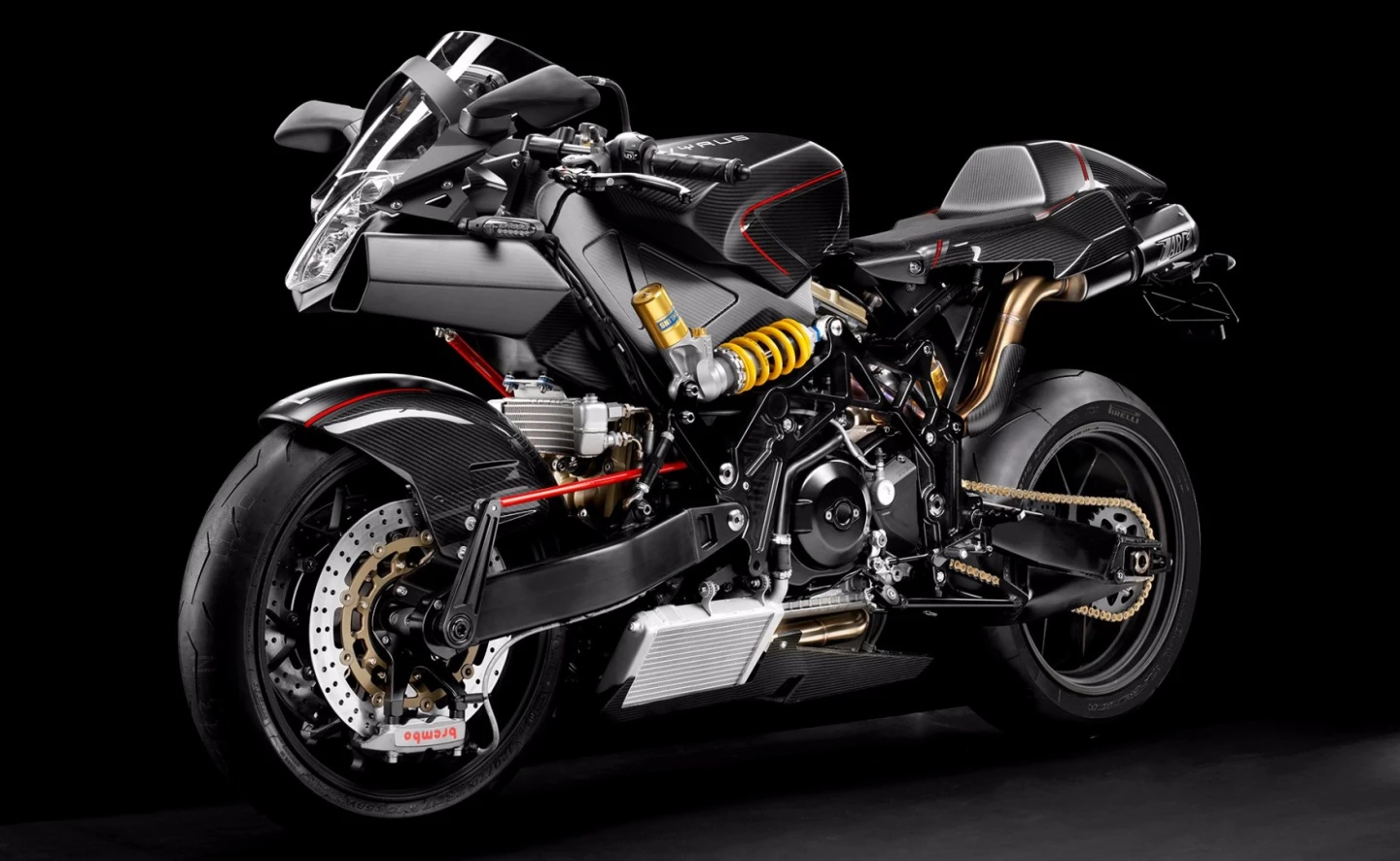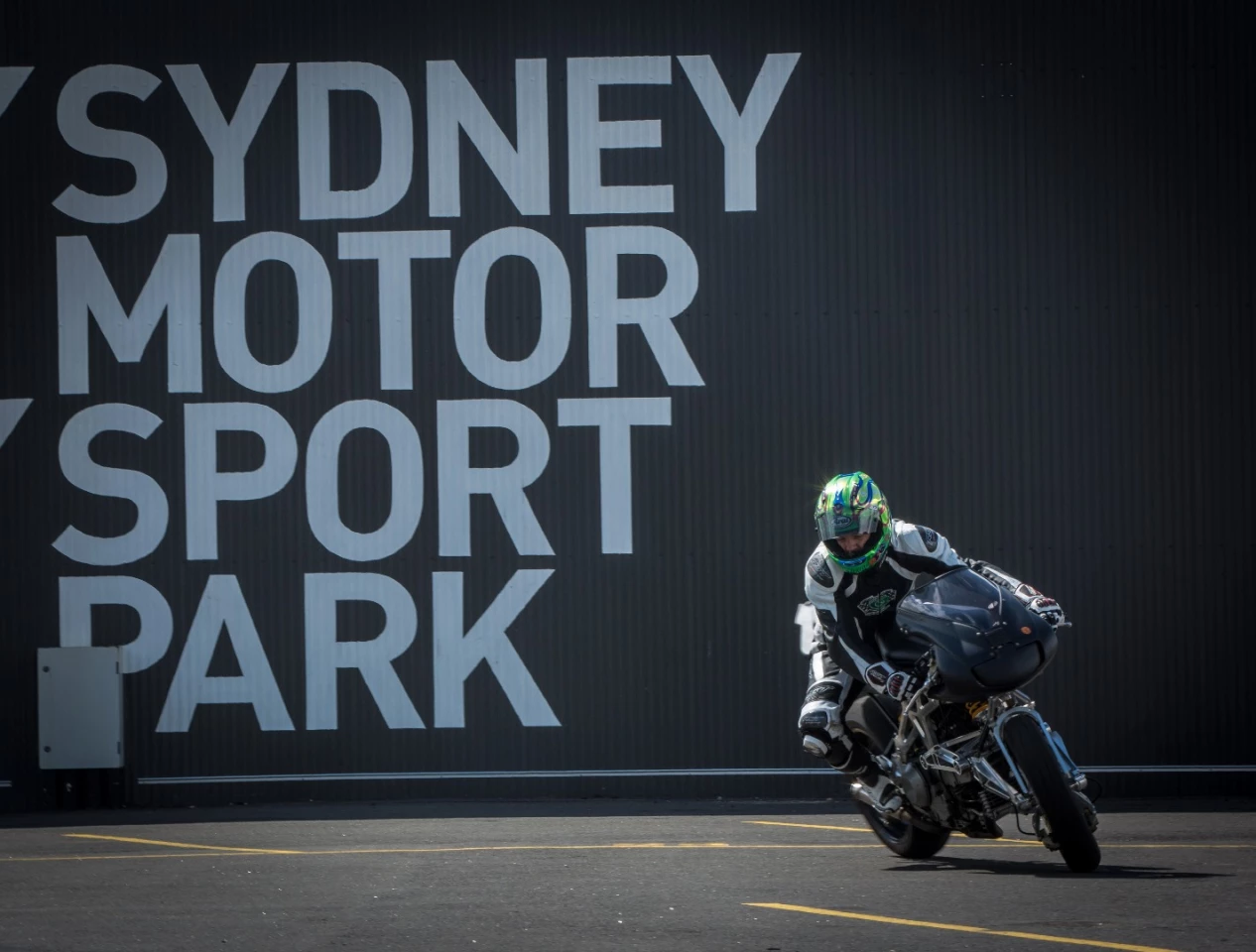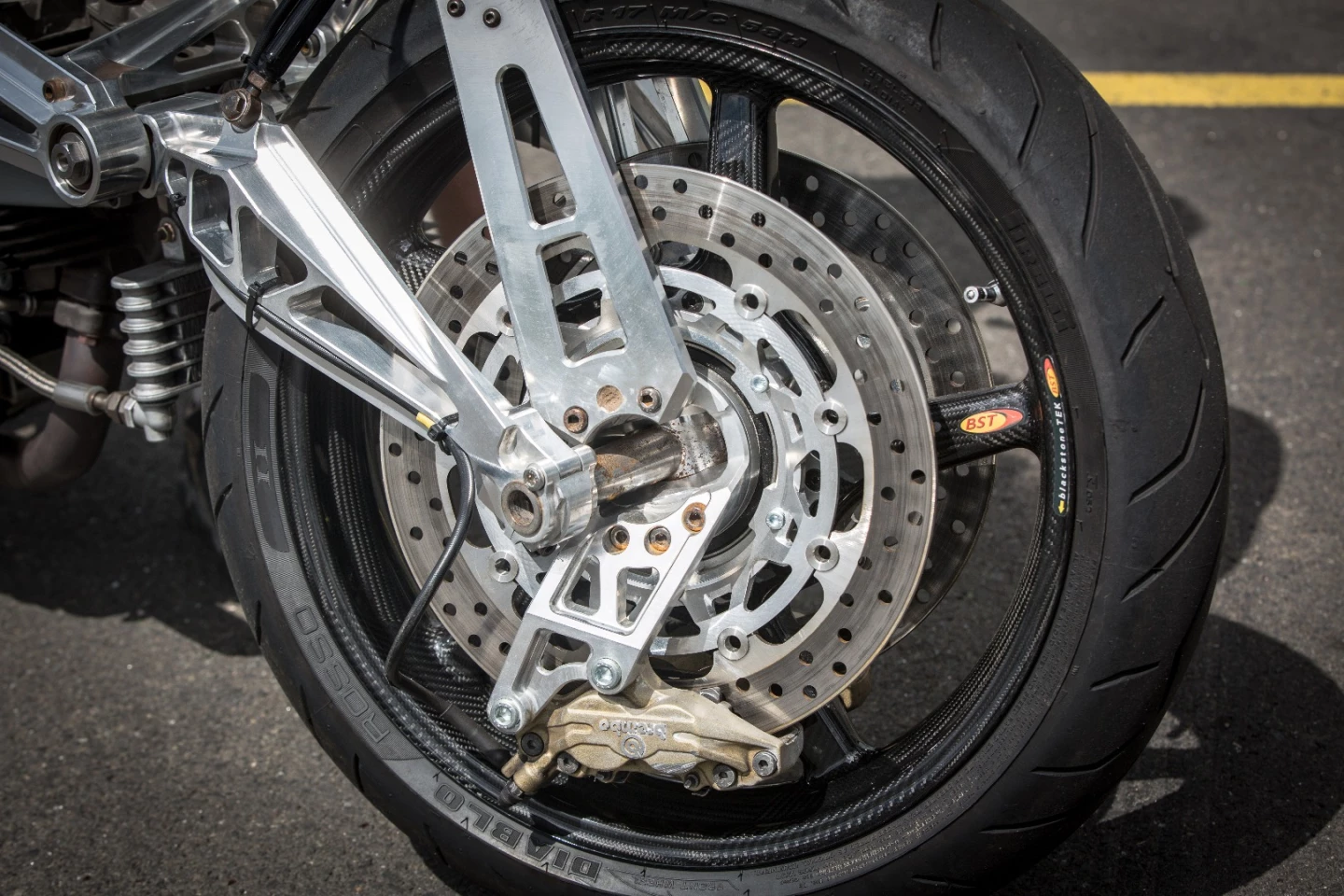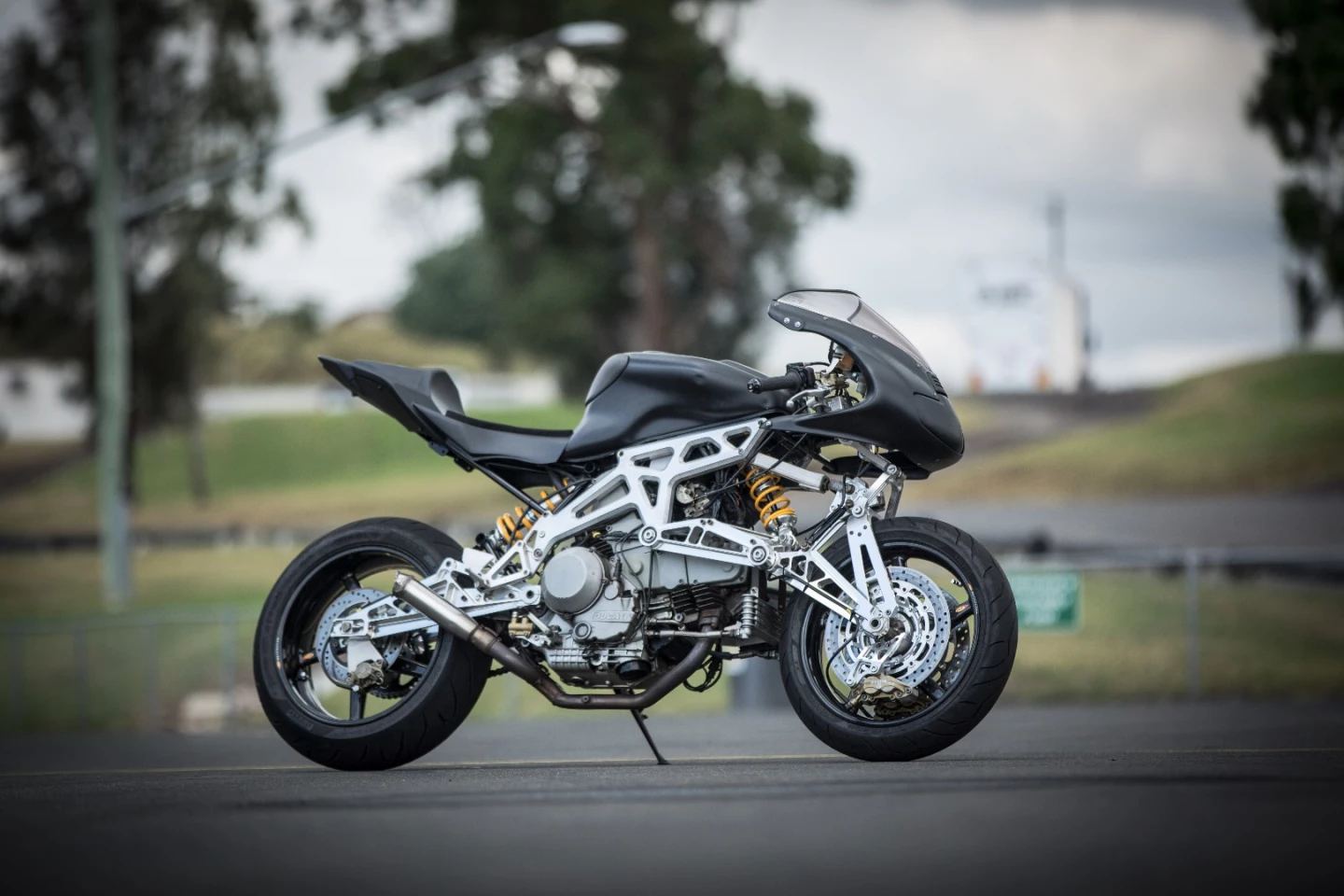Front suspension on a motorcycle has always been a matter of compromise. Telescopic forks have stuck around for nearly a hundred years because they're the least bad solution we've found so far - but an Australian team believes it's finally built the front end that could relegate forks to the history books. It might look bizarre, but the Motoinno system is lighter, it maintains constant geometry, it turns tighter and you can dial in whatever rake, trail, and degree of brake dive you want at the turn of a spanner. It's so stable under braking and into a corner that Motoinno says it's up to a whole second faster through a single corner than the same rider on a GSX-R750. Too good to be true? Loz flew to Sydney to find out.
On the front end of just about every motorcycle these days you'll find a pair of telescopic forks. There have been a bunch of alternatives over the years, but they've all had their drawbacks, and until now, forks have prevailed - even though they've got problems of their own. So for a bit of background, let's see what those problems are.
The problems with telescopic forks
Front suspension has to deal with a number of different forces when you're riding. First and foremost, it needs to keep the tire stuck to the ground through bumps. That's more or less an up and down force, unless the bike is leaned right over on its side in a corner, in which case there's a fair amount of sideways force as well.
Then there's braking forces - under hard braking, the tire generates a significant force that pushes straight backwards.

Telescopic forks join to the bike's frame at the steering head - so effectively they're a pair of 30-inch levers that amplify braking forces into that topmost front part of the frame. That means the headstock needs to be massively reinforced in metal - a significant weight penalty up high on the bike where you least want it.
Furthermore, even though most forks are now "upside down" with the thick outer tubes on top, and quite large at diameters up to 58 mm on some bikes, the fact is they still flex. They flex a little under braking, which can create stiction that makes it harder for the wheel to follow bumps - and they flex a little sideways as well, which can cause the front end to start wobbling when you're leaned right over in a corner - and sometimes leads to a lowside crash when the front wheel bounces itself off the road and loses traction.
Forks also "dive" under braking; the front end of the bike drops, sometimes all the way to the bottom of the suspension travel - and as the bike tilts forward, this changes the rake and trail steering geometry. A steeper rake can actually make the bike easier to turn, so sometimes this is an advantage on the racetrack - but it also makes the bike more unstable.
These problems are as old as forks themselves. As riders we simply ride around them, because no satisfactory alternative has popped up yet that didn't have bigger problems of its own.
The problems with hub-center steering
Case in point: hub-center steering like you can see on the current Bimota Tesi 3D and the Vyrus bike. This kind of arrangement sticks the front wheel onto a swingarm that runs straight back to the engine - which is wonderful for dealing with braking forces, and can completely eliminate brake dive - and steers the front wheel by tilting it on its axle.

Trouble is, the wheel has to tilt inside that front swingarm. So either you get a very narrow steering lock, or you get a wide front swingarm that can drag on the ground when you're cornering and lift the front tire off the deck. What's more, these bikes have long, angular and complicated connections between the handlebars and the front wheel, so you can end up with a dangerous degree of slop in the steering, and a very poor sense of connection to the front tire for the rider. It's not uncommon to be able to move the handlebar end up to a centimeter before the wheel starts moving.
There's other ideas out there, but that's enough background to understand the problems. And this crazy-looking jigger might just be the solution: the Motorcycle Innovations TS3.
The solution: Motorcycle Innovations' crazy-looking TS3 suspension system

In true and hilarious Australian style, co-founders Ray Van Steenwyk and Colin Oddy have shortened their company name to "Motoinno," so that's how we'll refer to them from here on.
Motoinno's solution is not a simple one. In fact, it takes a fair bit of time to get your head around. It's an entire motorcycle frame designed around a suspension idea that appears to eliminate the major problems of telescopic forks, while introducing none of the usual problems that crop up with hub center front ends. The Motoinno guys say it can be designed around pretty much any motor.
Looked at purely as a suspension system, the Motoinno front end operates as a parallelogram. The triangle that holds the wheel on stays at a constant angle, and there's two more arms from the top and bottom of that triangle that go straight back to pivot points at the top and bottom of the frame. That provides your direct brace against braking forces, and it makes for a bizarre thing to watch, as my brother Chris will demonstrate below, in a glorious motion that gives us an idea of what to expect on his upcoming wedding night:
The next step is to steer that front wheel. The Motoinno design tilts the forward beam of the wheel holding triangle to steer the wheel - the lower beam and the parallelogram suspension stays firm while the wheel steers. The handlebars connect to the steering mechanism via a simple pair of scissor links that isolate suspension action from the handlebars themselves. Again, it's easiest just to watch it in action.
You can tune your rake and trail to a wide degree, and also dial in whatever degree of brake dive you're comfortable with - including no dive at all, or even reverse dive, where the front end actually lifts under braking if you really want to bake your own noodle.
Finally, let's make Chris work both the suspension and steering at the same time, until he realizes how silly he looks:
You can think of the system as something like a MacPherson strut car suspension system. So, what we've got here is:
- a very direct connection between the steering and the front axle;
- excellent braking force management through to the frame;
- total control over brake dive or rise, without affecting steering geometry at all;
- minimal sideways flex and zero front-to-back flex;
- tuneable rake and trail geometry;
- no large swingarm that might drag on the ground when leaned over;
- a total frame and suspension system that actually comes out lighter than a forked bike, because it doesn't need a massively reinforced steering stem;
- and, a nice, wide steering lock that allows tight u-turns.
When we arrived at Sydney Motorsports park to test the Motoinno prototype, the guys had the front end tuned to dive a little under brakes - mainly because that's part of the feedback riders are conditioned to use to feel how hard they're braking. The system was set such that it would dive to no more than about 25 percent of the available suspension travel on the front monoshock, allowing the rest of the travel to deal with bumps in the braking zone.
What's it like to ride?
Riding it around at slow speed in the car park, the most noticeable thing about the Motoinno bike was … that it just felt like a regular forked bike. That's actually a big deal; there isn't a millimeter of slop in the steering, feel from the front wheel through the bars is excellent, and the steering lock allows you to turn very tightly, much tighter than you'd expect from a hub-steered bike and in fact even tighter than some forked bikes.
The dialled-in brake dive feels very natural, and the bike is so smooth and stable under brakes that I quickly found myself lifting the back end with confidence and ease. At slow speeds, it handles great.

At faster speeds … well, due to a scheduling stuff-up, I didn't get the chance to ride the Motoinno bike in anger on the racetrack. That sucks. But Isle of Man champion Cameron Donald did get three quick laps in at a tentative pace, feeling the bike out, and he was kind enough to give us a few comments.
"The bike amazingly feels quite conventional in the way it handles on the track, which is the biggest surprise to me. It's not what you'd expect, because it certainly doesn't look conventional. The way it turns into a corner, and the way it has some dive under brakes and whatnot, is actually very similar to a conventional forked motorcycle.
"I've had limited experience on center hub steered bikes, but what I saw as the big positive to this was the way that I could trail brake into the corner and hold a very tight line. You've still got an amount of dive, the way the boys have got it set up, but you can trail brake into the corner well past where you normally would on a conventional bike, and with a lot more brake pressure. That's something that will take some time to get used to, because it's so different to a conventional bike.
"It felt like it had good connection. In some of these hub steered bikes, with the amount of pivots and angles involved, you can lose that connection. There's none of that. The connection, the feel between the input to the handlebar and the response in the tire is very good.
"The big thing for me was how quick it gave me confidence, how much feel I had through the front tire, the connection between my input at the handlebars and the response from the tire was excellent, very much like a conventional motorbike. When you look at the amount of work in the linkage setup, you could easily think there'd be slop in there or you'd lose some feeling, but I didn't. It was very direct. That was a big positive.
"A race bike's the next step, to take it to that next level and push it harder and see how it responds. Like all bikes, the harder you push them, the more you learn about them, and that'll be the case with the TS3 as well."
In cases where testers have had enough time and laps to start extracting the most from the system, the Motoinno team claims the bike's deep braking chops and handling aptitude have given it an advantage of up to a whole second per corner over a GSX-R750 with the same rider. Not per lap, per corner, according to their telemetry. The cornering line is totally different, it brakes ridiculously deep into a corner while banked over, and the team says the bike turns tighter for a given lean angle than a regular bike as well.

Taking the Motoinno concept to the limit: going racing in Moto2
Either way, even a couple of tenths of a second per corner would be an absolutely massive advantage in racing terms, and the Motoinno team are so confident in their design that they're taking it straight to the top levels of competition.
While the current TS3 bike is an AU$300,000 prototype built around a 1993 Ducati Super Sport 900, the team is arranging finance and tooling up to build a Motoinno frame around a Honda CBR600 engine and take the whole thing racing in Moto2, the category just under MotoGP.
The suspension system is designed such that most of it can be built in carbon fiber to reduce weight even further. The Motoinno team has a promising young rider lined up, they're getting close on finance, they've already got their hands on a Honda-prepared Moto2 engine and other parts ready to go, and they're very confident they can make a splash and perhaps even take home some silverware in a racing category where engines, tires and electronics are standardized and chassis design can really shine.
This won't be the first time an alternative front end has gone out in Moto2 - the Vyrus team had a go at it last year with a hub-center steered bike, but didn't record better than 16th place over 7 races.

Initial plans are to enter just two or three Moto2 races later this season, but the ultimate goal for Motoinno is twofold. First, they want to license the suspension technology to volume manufacturers, and second, they want to manufacture their own high-end boutique superbikes built around the Ducati Testastretta 1200 motor out of the current Multistrada.
It remains to be seen how the Motoinno system performs in competition - and I haven't had a chance to experience the bike's vaunted abilities at speed yet. But I can attest it certainly seems to have successfully eliminated the biggest problems with other hub-center steering systems, those being steering slop, overly wide front swingarms, poor feel to the front tire and a narrow steering lock. If it can match the performance of a hub-center system under brakes and in a turn, and it looks like it should, this thing could set the racing world on fire.

The Motoinno frame looks great, if a little confusing at the front end. The rest of the frame looks like a leaping cheetah; it'd almost be a pity to hide it under Moto2 bodywork. But at the end of the day it's all about performance - making a better, safer, motorcycle that can get around a track faster. Racing is a logical and necessary next step, even if I'm not totally convinced they need to take it straight to the white-hot furnace of Moto2.
Either way, we wish the team the best of luck and look forward to seeing how the project develops.
To read Cam Donald's full thoughts on the TS3, check out the next issue of Motorcycle Trader.
More information: Motorcycle Innovation
































